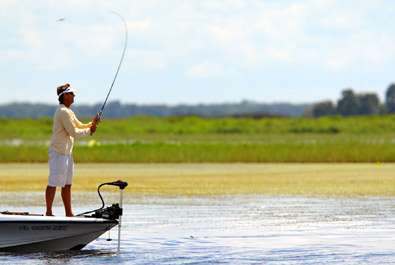
The concept of pattern fishing for bass was first defined by Roland Martin in 1969: “A ‘pattern’ is the exact set of water conditions such as depth, cover, structure, temperature, clarity, currents, etc., which attracts fish to a specific location and to other similar locations all over the same body of water.” In Pro Patterns, we interview a top bass fishing expert to get insights and details of his favorite pattern that will help you catch more and bigger bass. Print these patterns to create a notebook that will help you catch bass anywhere and anytime.
Bernie Schultz has been fishing professionally since the 1980s. Coming from Florida, he’s an expert at fishing shallow water and heavy vegetation. As a young pro he worked with the designers at the Hildebrandt Lure Company to create the perfect spinnerbait for fishing emergent and submerged vegetation. The result was “The Blade” and the “Tin Roller.” They’re his favorite tools for tackling grass and weeds, especially when the wind’s blowing.
Seasons
Spring
Summer
Fall
Winter (in the Deep South)
Water Conditions
Water temperature: 50-85 degrees
Water color: Clear to slightly stained (2 feet of visibility or more)
Wind/current: Strong enough to create alleys and funnels through the vegetation. The heavier the cover, the stronger the wind will need to be to create the alleys and funnels.
Structure/Cover
Structure: Flats and banks with vegetation.
Cover: Emergent or submerged vegetation that is visible to anglers.
Depth: 2-6 feet, but occasionally deeper depending on the vegetation and strength of the wind.
Tackle
Lure: Hildebrandt spinnerbaits — The Blade in 1/2 ounce and the Tin Roller in 3/8 ounce; best colors for both baits are silver shad, golden shiner and alewife. Tandem willowleaf blades are standard equipment on these spinnerbaits. Because these spinnerbaits are made of tin rather than lead or tungsten, they are less dense and do not get mired in the vegetation as easily. These baits were painstakingly designed to mimic baitfish — from their profile to the shape of the head and to every cosmetic detail such as accented gill plates, lifelike gel eyes and color grading in the skirt and head patterns. Those components are critical to the design and success of the lure. For more information, visit www.yakimabait.com.
Rod: 6 1/2-foot medium-heavy action Shimano casting rod for the lighter spinnerbait and a 7-foot medium-heavy action Shimano casting rod for the heavier spinnerbait.
Reel: Shimano Calais with a 6.2:1 or 7:1 gear ratio.
Line: Sufix Tritanium monofilament in 15- to 25-pound test, depending on the density of the cover.
Presentation
Cast/Flip/Pitch: The clearer the water, the more important it is to make long casts. For this pattern, make your casts with the wind. Casting downwind makes accuracy and boat control much easier.
Retrieve: Bring the spinnerbait back high in the water column, against the wind and with the grain in the grass or other vegetation. Steer the bait through the alleys and funnels of vegetation that have been created by the wind. Ultimately, water temperature and experimentation will determine the retrieve speed. Generally, you’ll want a faster retrieve when the water is warmer.
Keys to Success
Your goal with this pattern is to create reaction strikes from bass that are facing into the current (wind) and expecting their food to be moving in the same direction as the current. By bringing the spinnerbait back against the current and above the fish, many of them will be surprised by it and strike out of reflex or instinct. Bass will often run down and eat a spinnerbait under these conditions.





